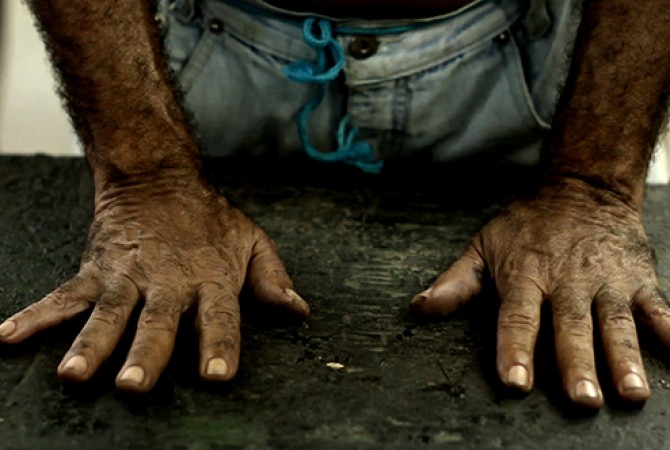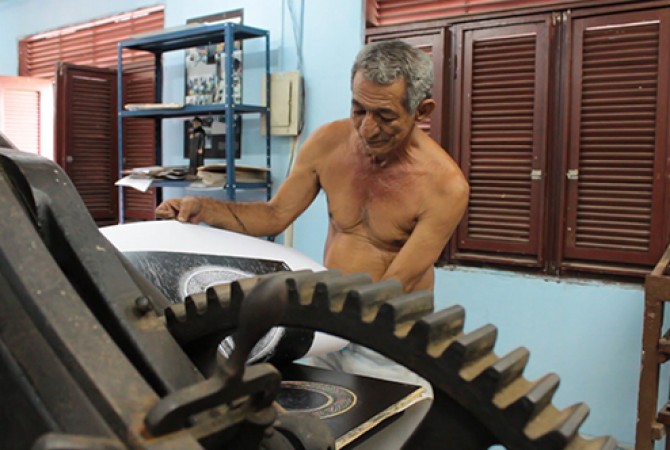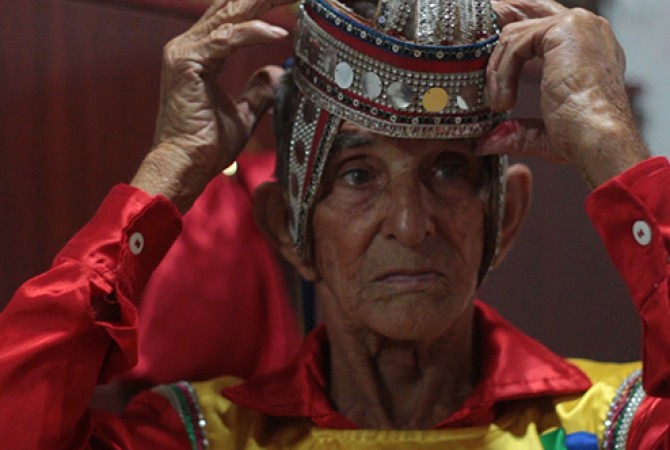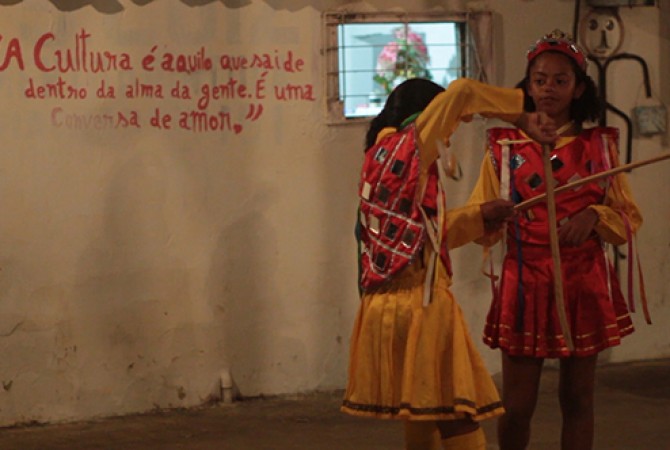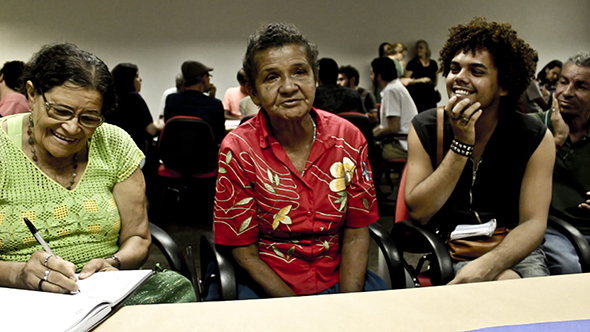
Regional encounter, Publicness in Art: Multiple Forms of Making and Knowledge, May 17th, 2014, Juazeiro do Norte, Cariri Cultural Center of the Bank of Northeast. Filmstill: Daniel Leão
Multiple Forms of Making and Knowledge
Introduction and videos (Part 1 e 2)
Cariri Cultural Center of the Bank of Northeast, Juazeiro do Norte, Ceará
In the manifesto of the arts
Neither erudite or popular
On the wings of this peacock
All will blend
And everyone will now feel
The art of being enchanted
Mysterious peacock
Beautiful bird
Everything is mystery
In your flight.Francisco Bruno Elias da Silva, Cordel poet
and participants of Leonardo Guelman’s group at Multiple Forms of Making and Knowledge1
The project Publicness in Art aimed to reflect on the esthetic and ethical complexities of what constitutes publicness in art and how to characterize, explore and think about public engagement with contemporary artistic production focusing on three distinct Brazilian contexts and regions: Rio de Janeiro, Porto Alegre and Juazeiro do Norte, Sertão.2
The third encounter in the series was “Multiple Forms of Making and Knowledge” held in Juazeiro do Norte, Cariri, in the state Ceará in northeast Brazil. The ‘encounter’ comprised field visits and a special gathering at the Cultural Center of the Bank of Northeast in Juazeiro, which brought together artists, artisans, musicians, poets, researchers, and masters of Reisado3 with university students for a conversation about the interfaces between art and society, the regional context, the imaginary, the popular, craftsmanship, and the emergence of new artistic practices. The event was supported by the Cultural Center of the Bank of Northeast in Cariri and planned in collaboration with Jacqueline Medeiros, manager of Cultural Center of the Bank of Northeast in Fortaleza (neighboring state). The artist José Rufino, researcher in popular culture of the Sertão and professor at the Federal Fluminense University (UFF), Leonardo Guelman, now director of the UFF Arts Center, director/curator of the Museum of Contemporary Art of Niterói (MAC) and art professor at UFF, Luiz Guilherme Vergara, and Nuno Sacramento, director of the Scottish Sculpture Workshop (SSW) in Scotland. The project also featured the special participation and collaboration of Sertão researcher, Felipe Caixeta and the videographer Daniel Leão.
The entire program was filmed and edited by Daniel Leão. Presented here in two parts, approximately 25 minutes each: (At present the video is only available in Portuguese.)
The discussions, including a montage of material gathered during field visits
Group presentations
This encounter (indeed series of encounters) would not have been possible without the generous collaboration of Cariri Cultural Center of the Bank of Northeast, particularly Robério Oliveira da Silva and especially of the project collaborators: Daniel Leão, Felipe Caixeta, Jacqueline Medeiros, José Rufino, Leonardo Guelman, Luiz Guilherme Vergara, and Nuno Sacramento.
A very special thanks to all those who participated: Adelmar Ribeiro Palitot, Adriana B. Botelho, Aécio Rodrigues de Oliveira, Aglaíze Damasceno, Ana Cláudia de Sousa Farias, Anacã Rupert Moreira Cruz e Costa Agra, Anália Lobo Mesquita, Andréa Sobreira de Oliveira, Antonio Beethoven da Silva Eustaquio, Ariadne Souza de Morais, Cicera Silva dos Santos, Cicero Rogério Venancio da Silva, Cristina Dunaeva, Denily de Souza Costa, Edilania Vivian Silva dos Santos, Emrah Kartal, Fábio Souza Tavares, Francisco Bruno Elias da Silva, Francisco de Assis (Mestre Cachoeira), Francisco Diêgo Vieira de Oliveira, Francisco Gomes Novais (Seu Nena), Francisco Leonardo Ferreira Neto, Franklin Roosewelt Menezes de Lacerda, Gleison Amorim da Silva, Isaias Paulo Nunes de Almeida, Janaina Felix Julio, Jaqueline Barbosa Rodrigues, Jefferson de Albuquerque Junior, José Lourenço Gonzaga, José Nilton de Souza, José Renner Benevides de Alencar, José Stênio Silva Diniz, Juninho Batista, Juraci Barbosa Alves, Karina Pereira de Sousa, Karol Luan Sales Oliveira, Larissa Rachel Gomes Silva, Manoel Inácio Gomes, Maria da Paz Mendes Vieira, María do Horto, Maria do Rosário Lustosa da Cruz, Maria José da Silva (Mestre Lúcia), Nezite Alencar, Rafael Moraes de Lima, Rafael Vilarouca Peixoto Correia, Raquel de Santana Santos, Renato Dantas, Rildo Alves Araujo, Roberto M. Carvalho, Suelaine Lima Lucena Agra, Suyane Oliveira Santos, Verônica Leite Machado, Wandeállyson Dourado Landim Santos, Yago Gomes da Silva e Yasmine Moraes Alves de Lacerda.
We are also grateful to Marcia Muller and Heloisa Bueno for their help and assistance, Adriana Botelho and Dane de Jade for their suggestions of field visits and collaboration in encouraging others to participate in the encounter, José Renner and Ricky Seabra for their assistence on the day with filming and sound and Pablo Lerner for giving permission to use his wonderful music. Also we are appreciative of the time and welcome during our visits of Francisco de Freitas, Lira Nordestina, Mestre Noza, Padre Giuseppe Venturelli and Mestre Aldenir and the Reisado (folk traditions) school.
José Rufino, Leonardo Guelman and Nuno Sacramento contributed essays to this publication: Rufino a poetic reflection on his experience and Leonardo and Nuno a collage/dialogue of texts and images. Daniel Leão also edited a visual video-essay of his impressions.
_
1 An invented song mixing traditions of Cordel and a famous old song from the region about a mysterious peacock, written by the Cordel poet Francisco Bruno Elias da Silva and participants of Leonardo Guelman’s group at the encounter Multiple Forms of Making and Knowledge, May 17th, 2014. Free translation.
2 Publicness in Art was a series of regional seminars coordinated by Instituto MESA and funded by the 10th edition of the Brazilian National Art Foundation’s (Funarte) grant initiative, Networks of Encounters in the Visual Arts. The series aimed to reflect on the ethical and aesthetic complexity and public roles and possibilities of contemporary artistic production in three distinct national regions and contexts: a) city and periphery of Rio de Janeiro/State of Rio de Janeiro b) Porto Alegre/State of Rio Grande do Sul and c) Juazeiro do Norte, Cariri/Sertão region/State of Ceará. Each regional seminar assumed a distinctly different format and thematic focus and was planned in collaboration with local institutions, artists, curators, and educators: Rio de Janeiro with Casa Daros and the institution’s manager of art and education, Bia Jabor, former director of art and education Eugenio Valdés Figueroa, and Art is Education program coordinator, Roberta Condeixa; Porto Alegre with independent curator/educator Mônica Hoff, also former coordinator of the pedagogic project of the Mercosul Biennial Foundation and one of the curators of the 9th Mercosul Biennial and the artists/educators Diana Kolker and Rafa Éis, members of Coletivo E, who also participated in the pedagogic project programs in this and other biennials; Juazeiro do Norte with Cariri Cultural Center of the Bank of Northeast and the manager of the Cultural Center of the Bank of Northeast, Fortaleza, Jacqueline Medeiros, the artist José Rufino, the director of the Museum of Contemporary Art, Niterói (MAC) and Federal Fluminense University (UFF) art professor, Luiz Guilherme Vergara, researcher in popular culture focusing on the Sertão region and director of the Arts Center at UFF, Leonardo Guelman, and the curator and director of the Scottish Sculpture Workshop, Nuno Sacramento, as well as the participation and collaboration of Felipe Caixeta, researcher of the Sertão region and masters student at UFF and the videographer Daniel Leão. Subsequently, a national seminar was organized in collaboration with MAC that brought together regional perspectives and discussed questions arising from the debates in each locale. In addition to the institutional and regional collaborators other national seminar invitees included: researchers Sabrina Marques Parracho Sant’anna and Tania Rivera; critic/curator Frederico Morais, who spoke for the first time publicly on the 1997 inaugural edition of the Mercosul Biennial; the artist Katie Van Scherpenberg who performed 14+1: sal grosso sobre areia (14 + 1 sea salt on sand) an invention on the Boa Viagem beach next to the museum; and the collective ¡NoPasaran!, who presented their film É tudo mentira (Everything is a Lie.).
3 Reisado (literally epiphany) is a popular folk festival introduced to Brazil by the Portuguese during the colonial period and still has a vital presence in many Brazilian cities. The name comes from festivals related to the Feast of the Epiphany (in Portuguese Dia dos Reis – literally Day of the Kings) celebrated on the 6th of January each year. For the most part festivals happen on the streets as processions or community gatherings such as near/on church grounds. One of the characteristics of reisado is the costume worn by participants including colorful clothes, ribbons, hats, and tiny mirrors. Special dances feature particular rituals and “masters” artfully train future generations in these traditions. Traditional musical instruments include special guitars, drums, tambourines, and fiddles. See reisado. In Britannica Escola Online. Enciclopédia Escolar Britannica, 2015. Web, 2015. Disponível em: http://escola.britannica.com.br/article/483505/reisado (Accessed February 2015)




